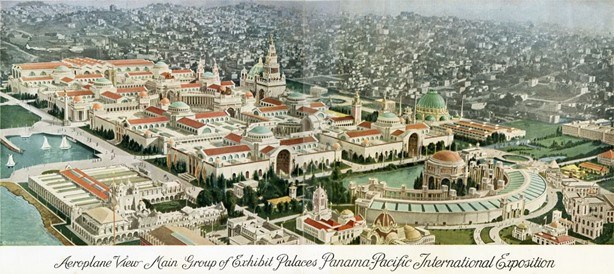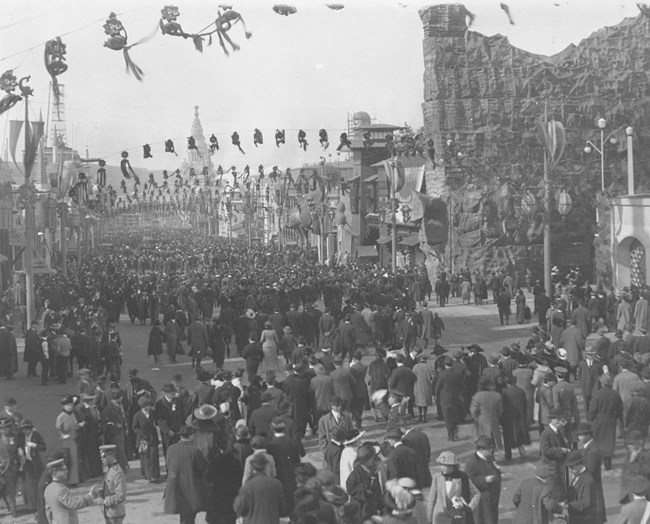Last updated: December 27, 2022
Article
50 Nifty Finds #4: Getting In the Zone
For more than a century the National Park Service (NPS) has won awards and honors for its work preserving cultural and natural resources and sharing the diverse stories of American history. One of its earliest honors came from the Panama-Pacific International Exposition held in San Francisco, California, in 1915. But wait…The NPS was created in 1916, right? How could it win an award before it existed?
Panama-Pacific International Exposition
World’s fairs and international expositions were popular events in the 1800s and early 1900s: they drew large crowds to host cities. From February 20 to December 4, 1915, San Francisco hosted an international exposition to celebrate the 1914 opening of the Panama Canal and the development of the Pacific Coast as a center for international trade. It was also a way for the city to show it had recovered from the devastating 1906 earthquake.

The fairgrounds covered 635 acres along 2.5 miles of waterfront property near the Presidio. The centerpiece was the Tower of Jewels, the entrance to the Court of the Universe. Exhibit palaces showcased the “newest and greatest aspects of human culture, creativity, and ingenuity form around the globe.” State buildings featured reproductions of capitol buildings, state resources, and symbols of statewide pride. Visitors filed past the Liberty Bell. The Battle of Gettysburg Cyclorama was exhibited during the exposition. Many countries sent exhibits for the foreign pavilions even as World War I raged in Europe. Other exhibits focused on production, manufacturing, medicines, and science. The carnivals of “The Zone,” international food vendors, nightly fireworks displays, and daily celebrations focusing on specific countries or places, like Glacier National Park Day (June 15), added to the fun. There was so much to see and do that it’s said that if someone attended the exposition for 24 hours a day each day it was open, they still wouldn’t have been able to see all the exhibits.
The exposition was a huge success. Over 18 million people came, including about 460,000 from the East Coast who came by train and 15,000 people who drove their cars.

Parallel Tracks
The Atchison, Topeka & Santa Fe (AT&SF) and the Union Pacific railroads each invested about $500,000 to create and maintain national park exhibits at the exposition. The railroad companies, early supporters of national parks, expected to benefit from the publicity (and customers) the exhibits would bring them, but the scale and scope of what they created is mind boggling.
The exhibits, constructed in “The Zone,” included a six-acre replica of the Grand Canyon and a Pueblo village. Visitors could ride on one of the eight full-scale, 40-passenger rail cars for a virtual trip across 100 miles of the canyon’s landscape. It was described as “in many respects, the greatest exhibit ever built in any exposition.” The AT&SF Railroad spent $300,000 (over $8 million today) to build it. The exhibit brochure ended with “And after you have seen the reproduction, see the REAL Grand Canyon, en route home.”
The Union Pacific Railroad built the 4.5-acre Yellowstone National Park exhibit, complete with the 1,000-seat Geyserland Spectatorium and a working replica of Old Faithful that spewed boiling water and steam every 20 minutes. The 85-foot-tall model of Yellowstone Falls used 10,000 gallons of water per minute. The Old Faithful Inn could seat 2,000 guests for dinner. Although both exhibits lost money, they were triumphs in advertisements for the railroads—and national parks.
While not as showy (or expensive!) as the railroad exhibits, the US government also had exhibits promoting parks. In advance of the event, Secretary of Interior Franklin K. Lane launched a park preparedness plan to publicize the parks and ready them for more visitors. Yosemite National Park was featured in the official exposition program. Private cars were officially allowed into Yellowstone National Park for the first time on August 1, 1915. Once at the exposition, visitors to the Palace of Liberal Arts were offered a “panorama of Yosemite National Park and of Mount Rainier,” a relief map of Yosemite Valley, and large photographs and lantern slides illustrating several national parks.
Millions of people saw these exhibits. Thousands more visited national parks on their way to and from San Francisco. Members of Congress also visited parks while traveling to the exposition. They also heard from voters who visited parks and read newspaper and magazine accounts of the parks’ wonders. The exposition played an important part—at a crucial time—in increasing public and political support for creating the NPS.

Medals of Award
Reflecting the scale of the exposition, more than 25,000 awards were given for the best products or exhibits, including over 20,000 medals. Gold-plated, silver-plated, and bronze medals, often in presentation boxes, were among the six classes of awards. The NPS History Collection includes two of three bronze medals of award won for exhibits at the exposition.
The medal was designed by John Flanagan (1865–1952) and struck at the Philadelphia Mint. Flanagan studied under August Saint-Gaudens and worked as his studio assistant. He also studied at the Ecole des Beaux-Arts in Paris and became well known for his coins and medals.
The obverse (front) of the medal features a nude man and woman standing on either side of the Central American isthmus, with a rising sun and clouds in the background. They symbolize the joining of the Atlantic and Pacific oceans by the Panama Canal. The Latin phrase “Divine Disivncta Ivnxit Homo” (Man through divine inspiration has joined what had been separated) is below the figures.

The reverse (back) features the Tower of Jewels behind crossed leaves. Around the edge of the medal it reads, “Panama-Pacific International Exposition San Francisco MCMXV.”
The collection also includes a bronze plaque that reads, “Presented to the National Park Service, US Department of the Interior by the Panama-Pacific International Exposition in recognition of it’s [sic] cooperation. March 13th, 1915, San Francisco.”
The exposition gave these commemorative plaques to governments, organizations, and businesses that provided exhibits. Although thousands of them were made, this one is noteworthy because it was given to “the National Park Service.” The lobbying efforts to establish a “bureau of national parks” that began as early as 1908 were seemingly willing the NPS into existence 17 months before President Woodrow Wilson officially created it on August 25, 1916.

Sources:
“All Set for the West: Railroads and National Parks.” Accessed at https://www.uprrmuseum.org/uprrm/exhibits/traveling/national-parks/index.htm
Golden Gate National Recreation Area, “The Panama-Pacific International Exposition.” Accessed at https://www.nps.gov/goga/learn/historyculture/ppie.htm
"Grand Canyon of Arizona Replica” brochure. Accessed at https://prism.lib.asu.edu/_flysystem/fedora/c313/CE_EPH_DG-61.pdf
“Official Guide of the Panama-Pacific International Exposition, San Francisco 1915.” Accessed at https://ia800107.us.archive.org/27/items/officialguidepa00pana/officialguidepa00pana.pdf
"Medal of Award, Panama-Pacific International Exposition.” Accessed at https://www.metmuseum.org/art/collection/search/15976
“Miscellaneous Medals of Award.” Accessed at http://www.sanfranciscomemories.com/ppie/medals.html
National Park Service, “Panama-Pacific International Exposition: The Worlds Meets in San Francisco.” Accessed at https://www.nps.gov/goga/learn/historyculture/upload/PPIE-Brochure-FINAL-for-Web.pdf
Presidio of San Francisco, “1915 Panama-Pacific International Exposition.” Accessed at https://www.nps.gov/prsf/learn/historyculture/1915-panama-pacific-international-exposition.htm
Shaffer, Marguerite S. 2001. See America First: Tourism and National Identify, 1880-1940. Smithsonian Institution, Washington, DC.
*Translation of the Latin motto on the medal courtesy of Daniel Schoos, former seasonal ranger and Latin teacher.
Tags
- gettysburg national military park
- golden gate national recreation area
- grand canyon national park
- independence national historical park
- presidio of san francisco
- saint-gaudens national historical park
- yellowstone national park
- yosemite national park
- nps history
- nps history collection
- hfc
- panama-pacific international exposition
- medal
- plaque
